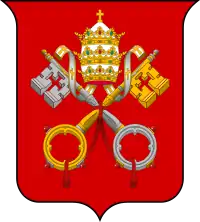Roman Curia
The Roman Curia (Latin: Romana Curia ministerium suum implent) comprises the administrative institutions of the Holy See[note 1] and the central body through which the affairs of the Catholic Church are conducted. It acts in the pope's name and with his authority for the good and for the service of the particular churches and provides the central organization for the church to advance its objectives.[1][2][3][note 2]
| Part of a series on the |
| Roman Curia |
|---|
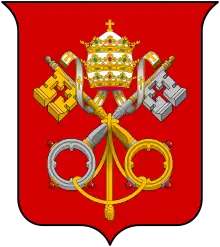 |
|
|
The structure and organization of responsibilities within the Curia are at present regulated by the apostolic constitution Pastor bonus, issued by Pope John Paul II on 28 June 1988.[5] A reform of the Roman Curia under Pope Francis,[6][7][8] with a new apostolic constitution, is currently planned.[9]
Other bodies that play an administrative or consulting role in ecclesial affairs are sometimes mistakenly identified with the Curia, such as the Synod of Bishops and regional conferences of bishops. Cardinal Gerhard Müller, former prefect of the Congregation for the Doctrine of the Faith, wrote in 2015 that "the Synod of Bishops is not a part of the Roman Curia in the strict sense: it is the expression of the collegiality of bishops in communion with the Pope and under his direction. The Roman Curia instead aids the Pope in the exercise of his primacy over all the churches."[10]
Historical background
Curia in medieval and later Latin usage means "court" in the sense of "royal court" rather than "court of law". The Roman Curia is sometimes anglicized as the Court of Rome, as in the 1534 Act of Parliament that forbade appeals to it from England.[11] It is the papal court and assists the Pope in carrying out his functions. The Roman Curia can be loosely compared to cabinets in governments of countries with a Western form of governance, but the only sections that can be directly compared with specific ministries of a civil government are the Second Section of the Secretariat of State, known also as the Section for Relations with States, the Pontifical Commission for Vatican City State (established in 1939 by Pius XII), and the Congregation for Catholic Education,
It is normal for every Latin Catholic diocese to have its own curia for its administration. For the Diocese of Rome, these functions are not handled by the Roman Curia, but by the Vicariate General of His Holiness for the City of Rome, as provided by the apostolic constitution Ecclesia in Urbe. The pope has, going back to St. Peter, been the bishop of Rome. There is also the Vicar General of Rome, traditionally a cardinal, and his deputy the vicegerent, who holds the personal title of archbishop, supervise the governance of the diocese by reference to the Pope himself, but with no more dependence on the Roman Curia, as such, than other Catholic dioceses throughout the world. A distinct office, the Vicar General for Vatican City, administers the portion of the Diocese of Rome in Vatican City.
Until recently, there still existed hereditary officers of the Roman Curia, holding titles denominating functions that had ceased to be a reality when the Papal States were lost to the papacy. A reorganization, ordered by Pope Pius X, was incorporated into the 1917 Code of Canon Law. Further steps toward reorganization were begun by Pope Paul VI in the 1960s. Among the goals of this curial reform were the modernization of procedures and the internationalization of the curial staff. These reforms are reflected in the 1983 Code of Canon Law.[12] The offices of the Vatican City State are not part of the Roman Curia, which is composed only of offices of the Holy See. As of 2020, the Curia comprises the offices listed in the sections below. All members of the Curia except the Cardinal Camerlengo and the Major Penitentiary resign their office immediately after a papal death or resignation. See sede vacante.
Terminology
The principal departments of the Roman Curia are called dicasteries. The constitution of the church Pastor bonus (1988) provided this definition: "By the word "dicasteries" are understood the Secretariat of State, Congregations, Tribunals, Councils and Offices".[13] Those remain the five principal categories of departments, with the noteworthy change in that there is now more than a single Secretariat. Two new departments that began functioning on 1 August 2016 and 1 January 2017 were identified only as dicasteries – Dicastery for the Laity, Family, and Life and Dicastery for Promoting Integral Human Development. Both are headed by a prefect.
Secretariats
Secretariat of State
The Secretariat of State is the oldest dicastery in the Roman Curia, the government of the Roman Catholic Church. It is headed by the Secretary of State, since 15 October 2013 by Cardinal Pietro Parolin, who is responsible for all the political and diplomatic functions of the Holy See. The Secretariat is divided into two sections, the Section for General Affairs and the Section for Relations with States, known as the First Section and Second Section, respectively. The Secretariat of State was created in the 15th century[14] and is now the department of the curia most involved in coordinating the Holy See's activities. Matters not clearly within the competence of another dicastery are dealt with by the Secretariat of State.[15]
Secretariat for the Economy
The Secretariat for the Economy was established by Pope Francis in 2014, with the Australian Cardinal George Pell, formerly the Archbishop of the Roman Catholic Archdiocese of Sydney, as its Cardinal Prefect (2014 - 12 December 2018).
Dicasteries
Two departments of the Roman Curia established by Pope Francis in 2016 have been identified simply as "dicasteries" rather than as one of the traditional department types. A third dicastery was named on 23 June 2018.
Dicastery for the Laity, Family and Life
Pope Francis announced on 15 August 2016 the creation of the Dicastery for the Laity, Family and Life, effective 1 September 2016. It took over the responsibilities of the Pontifical Council for the Laity and the Pontifical Council for the Family.[16] As its first Prefect, Francis named Bishop Kevin Farrell of Dallas, Texas,[17]
Dicastery for Promoting Integral Human Development
Pope Francis announced the erection of the Dicastery for Promoting Integral Human Development on 31 August 2016, effective 1 January 2017. He named Cardinal Peter Turkson its first prefect. Combining the work of four Pontifical Councils established following the Second Vatican Council,[18] Pope Francis gave it responsibility for "issues regarding migrants, those in need, the sick, the excluded and marginalized, the imprisoned and the unemployed, as well as victims of armed conflict, natural disasters, and all forms of slavery and torture".[19] The Pope announced that "temporarily" he would personally direct the dicastery's Migrants and Refugees Section.[20][21]
Dicastery for Communications
Pope Francis established the Secretariat for Communications on 27 June 2015, incorporating the Pontifical Council for Social Communications; the Press Office of the Holy See (Vatican Press Office); the Vatican Internet Service (VIS); Vatican Radio; Vatican Television Center; the L'Osservatore Romano newspaper; Tipografia Vaticana; Servizio Fotografico; and the Libreria Editrice Vaticana. Monsignor Dario Edoardo Viganò, formerly the Director of the Vatican Television Center, was named the first Prefect.[22][23] Viganò resigned on 21 March 2018.
The Secretariat was renamed Dicastery for Communications on 23 June 2018,[24] and on 5 July 2018 Pope Francis appointed award-winning lay journalist Paolo Ruffini, as Prefect.[23]
Congregations
There are nine Roman Congregations in the Roman Curia, the central administrative organisation of the Catholic Church.[25] They are the second highest-ranking departments[26] and are a type of dicastery (department with a jurisdiction) of the Roman Curia. Each Congregation is led by a prefect, who is a cardinal.
Congregation for the Doctrine of the Faith
The Congregation for the Doctrine of the Faith (CDF), previously known as the Supreme Sacred Congregation of the Roman and Universal Inquisition, and sometimes simply called the Holy Office, is the oldest of the nine congregations of the Roman Curia. Among the most active of these major Curial departments, it oversees Catholic doctrine.[27] Its most familiar name for most of its history was the Holy Office of the Inquisition. Cardinal Luis Ladaria Ferrer has served as its prefect since 1 July 2017.
Congregation for the Oriental Churches

The Congregation for the Oriental Churches, established by Pope Benedict XV on 1 May 1917, is responsible for contact with the Eastern Catholic Churches for the sake of assisting their development, protecting their rights and also maintaining whole and entire in the one Catholic Church, alongside the liturgical, disciplinary and spiritual patrimony of the Latin Church, the heritage of the various Oriental Christian traditions. It has exclusive authority over the following regions: Egypt and the Sinai Peninsula, Eritrea and northern Ethiopia, southern Albania and Bulgaria, Cyprus, Greece, Israel, Iran, Iraq, Lebanon, Palestine, Syria, Jordan, Turkey, and Ukraine.[28] Its members include all Eastern Catholic patriarchs and major archbishops, as well as the President of the Pontifical Council for Promoting Christian Unity.[29] Cardinal Leonardo Sandri has served as its prefect since his appointment on 9 June 2007.
Congregation for Divine Worship and the Discipline of the Sacraments
The Congregation for Divine Worship and the Discipline of the Sacraments[30] handles most affairs relating to liturgical practices of the Latin Catholic Church as distinct from the Eastern Catholic Churches and also some technical matters relating to the Sacraments. It has been headed by Cardinal Robert Sarah as prefect since his appointment on 23 November 2014.
Congregation for the Causes of Saints
The Congregation for the Causes of Saints oversees the process that leads to the canonization of saints, passing through the steps of a declaration of "heroic virtues" and beatification. After preparing a case, including the approval of miracles, the case is presented to the pope, who decides whether or not to proceed with beatification or canonization.[31] As of September 2020, the last prefect, Cardinal Giovanni Angelo Becciu, has resigned and the post has not yet been filled.
Congregation for the Evangelization of Peoples
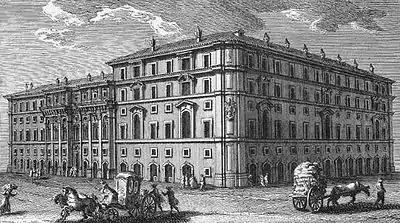
The Congregation for the Evangelization of Peoples is responsible for missionary work and related activities. It is perhaps better known by its former title, the Congregation for the Propagation of the Faith. Pope John Paul II renamed it in 1982 without altering its mission. Sr. Luzia Premoli, superior general of the Combonian Missionary Sisters, was appointed a member of the Congregation for the Evangelization of Peoples in 2014, becoming the first woman to be appointed a member of a Vatican congregation.[33] As of 8 December 2019, Cardinal Luis Antonio Tagle is the prefect.[34]
Congregation for the Clergy
The Congregation for the Clergy[35] is the department of the Roman Curia responsible for overseeing matters regarding priests and deacons not belonging to institutes of consecrated life or societies of apostolic life, as well as for the seminaries (except those regulated by the Congregations for the Evangelization of Peoples and for the Oriental Churches), and houses of formation of religious and secular institutes. The Congregation for the Clergy handles requests for dispensation from active priestly ministry, as well as the legislation governing presbyteral councils and other organizations of priests around the world. The Congregation does not deal with clerical sexual abuse cases, as those are handled exclusively by the Congregation for the Doctrine of the Faith.
Beniamino Stella of Italy has served as its prefect since 2013.
Congregation for Institutes of Consecrated Life and Societies of Apostolic life
The Congregation for Institutes of Consecrated Life and Societies of Apostolic Life[36] is the congregation of the Roman Curia responsible for everything which concerns institutes of consecrated life (religious institutes and secular institutes) and societies of apostolic life, both of men and of women, regarding their government, discipline, studies, goods, rights, and privileges. João Braz de Aviz of Brazil has served as its prefect since 2011.
Congregation for Catholic Education (Institutes of Study)
The Congregation for Catholic Education is responsible for:[37]
- universities, faculties, institutes and Catholic institutions of higher education, either
- Ecclesiastical, which are governed by the apostolic constitution Veritatis Gaudium (29 January 2018) and which are tasked "to explore more profoundly the various areas of the sacred disciplines (e.g., Theology Ecclesiastical Philosophy, Canon Law); or
- Non-ecclesiastical (offering secular sciences) dependent on ecclesiastical persons, which are governed by the apostolic constitution Ex corde Ecclesiae, as well as by the existing pertinent civil laws of countries in which they are collocated; and
- schools and educational institutes depending on ecclesiastical authorities.
Giuseppe Versaldi has headed it since 2015.
Congregation for Bishops
The Congregation for Bishops[38] oversees the selection of new bishops that are not in mission territories or those areas that come under the jurisdiction of the Congregation for the Oriental Churches who deal with the Eastern Catholics, pending papal approval. It consequently holds considerable sway over the evolution of the church. It also schedules the papal audiences required for bishops every five years and arranges the creation of new dioceses. This office is headed by Cardinal Marc Ouellet, PSS.
Tribunals
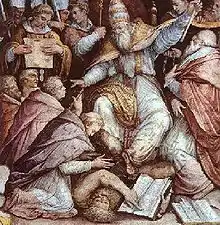
Apostolic Penitentiary
The Apostolic Penitentiary,[39] more formally the Supreme Tribunal of the Apostolic Penitentiary, is one of the three tribunals of the Roman Curia. The Apostolic Penitentiary is responsible for issues relating to the forgiveness of sins in the Roman Catholic Church. The Apostolic Penitentiary has jurisdiction only over matters in the internal forum. Its work falls mainly into these categories:
- the absolution of excommunications latæ sententiæ reserved to the Holy See,
- the dispensation of sacramental impediments reserved to the Holy See, and
- the issuance and governance of indulgences.
Tribunal of the Rota Romana
The Tribunal of the Roman Rota is the highest appellate tribunal.[40] While usually trying cases in appeal in third instance (as is normally the case in the Eastern Catholic Churches),[41] or even in second instance if appeal is made to it directly from the sentence of a tribunal of first instance, it is also a court of first instance for cases specified in the law and for others committed to the Rota by the Roman Pontiff.[40][42] It fosters the unity of jurisprudence and, through its own sentences, is a help to lower tribunals.[40]
The greater part of its decisions concern the nullity of marriage. In such cases its competence includes marriages between two Catholics, between a Catholic and non-Catholic, and between two non-Catholic parties whether one or both of the baptized parties belongs to the Latin or an Eastern Rite.[43]
The court is named Rota (Latin for: wheel) because the judges, called auditors, originally met in a round room to hear cases.[44]
Supreme Tribunal of the Apostolic Signatura
The Supreme Tribunal of the Apostolic Signatura[45] is the highest judicial authority in the Catholic Church besides the Pope himself, who is the supreme ecclesiastical judge. In addition, it is an administrative office for matters pertaining to the judicial activity of the whole church.
Appeals in standard judicial processes, if appealed to the Apostolic See, normally are not handled by the Signatura. Those go to the Roman Rota, which is the ordinary appellate tribunal of the Apostolic See. The Supreme Tribunal handles some of the more specialized kinds of cases, including the following:
- Petitions for a declaration of nullity against a Rotal decision;
- Conflicts of jurisdiction between two or more tribunals or dicasteries,
- Recourse against administrative acts of ordinaries and dicasteries (including some penal cases decided without using a court),
Although a Rotal decision can be appealed, if not res judicata, to a different panel (turnus) of the Rota, there is no right of appeal from a decision of the Signatura,[46] although a complaint of nullity on formal grounds is possible.[47] As an administrative office, it exercises jurisdiction (vigilance) over all the tribunals of the Catholic Church. It can also extend the jurisdiction of tribunals, grant dispensations for procedural laws, establish interdiocesan tribunals, and correct advocates.
Pontifical Councils
Pontifical Council for Promoting Christian Unity
The Pontifical Council for Promoting Christian Unity[48] is dedicated chiefly to the promotion of dialogue and unity with other Christian churches and ecclesial communities, but also, through a closely linked specific commission, to advancing religious relations with Jews.
Pontifical Council for Legislative Texts
The Pontifical Council for Legislative Texts has responsibility for interpreting church law.[49][50]
Pontifical Council for Interreligious Dialogue
The Pontifical Council for Interreligious Dialogue[51] is the central office of the Catholic Church for promoting of interreligious dialogue in accordance with the spirit of the Second Vatican Council, in particular the declaration Nostra aetate. It has the following responsibilities:
- to promote mutual understanding, respect and collaboration between Catholics and the followers of other religious traditions;
- to encourage the study of religions;
- to promote the formation of persons dedicated to dialogue.
Pontifical Council for Culture
The Pontifical Council for Culture[52] (Latin: Pontificium Consilium de Cultura) has as its mission oversight of the relationship of the Catholic Church with different cultures. The Pontifical Council for Dialogue with Non-Believers was merged with the Pontifical Council for Culture in 1993. On 30 July 2012, Pope Benedict XVI united the Council with the Pontifical Commission for the Cultural Goods of the Church.[52]
Pontifical Council for Promoting the New Evangelization
The Pontifical Council for Promoting the New Evangelization[53] is a pontifical council of the Roman Curia dedicated to catechetics and promoting the faith in parts of the world ("the West") where Christianity is well-established but is being affected by secularism.
Offices
The Holy See's financial authorities consist of two offices.
Apostolic Camera
The Apostolic Camera[54] was the central board of finance in the Papal administrative system, which at one time was of great importance in the government of the States of the Church and in the administration of justice, led by the Camerlengo of the Holy Roman Church.
Administration of the Patrimony of the Apostolic See
The Administration of the Patrimony of the Apostolic See[55] deals with the "properties owned by the Holy See in order to provide the funds necessary for the Roman Curia to function".[56] It was established by Pope Paul VI on 15 August 1967 and composed of two sections. The Ordinary Section continued the work of the Administration of the Property of the Holy See, a commission to which Pope Leo XIII entrusted the administration of the property remaining to the Holy See after the complete loss of the Papal States in 1870. On 8 July 2014, the Ordinary Section was transferred to the newly established Secretariat for the Economy. The Extraordinary Section administers the funds given by the Italian government to implement the Financial Convention attached to the Lateran Treaty of 1929. These funds were previously managed by the Special Administration of the Holy See.[57]
Prefecture for the Economic Affairs of the Holy See
The Prefecture for the Economic Affairs of the Holy See[58] was erected on 15 August 1967 and was entrusted with overseeing all the offices of the Holy See that managed finances, regardless of their degree of autonomy. It did not manage finances itself, but instead audited the balance sheets and budgets of the offices that did. It then prepared and published annually a general financial report. It was consulted on all projects of major importance undertaken by the offices in question.[57] On 31 March 2015, Pope Francis transferred its operations into the Secretariat for the Economy.
Pontifical commissions
Pontifical Commission for the Cultural Heritage of the Church
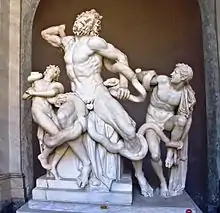
The Pontifical Commission for the Cultural Heritage of the Church[59] was established in 1988 by Pope John Paul II, with the purpose of guarding the historical and artistic patrimony of the entire church which included works of art, historical documents, books, everything kept in museums as well as the libraries and archives. On 30 July 2012, Pope Benedict XVI merged the Commission into the Pontifical Council for Culture.
Pontifical Commission Ecclesia Dei
The Pontifical Commission Ecclesia Dei[60] was established by Pope John Paul II on 2 July 1988 for the care of those former followers of Archbishop Marcel Lefebvre who broke with him as a result of his consecration of four priests of his Society of St. Pius X as bishops on 30 June 1988, an act the Holy See deemed illicit and schismatic. On 2 July 2009 this commission was closely placed under the auspice of the Congregation for the Doctrine of the Faith, whose Prefect was ex officio President of the Commission while maintaining its separate identity.[61] On 17 January 2019, Pope Francis merged the Commission into the Congregation for the Doctrine of the Faith.[62]
Pontifical Commission for Latin America
The Pontifical Commission for Latin America[63] is a dicastery of the Roman Curia. Established by Pope Pius XII on 19 April 1958, it is charged with providing assistance to and examining matters pertaining to the church in Latin America. The Commission operates under the auspices of the Congregation for Bishops.
Pontifical Commission for the Protection of Minors
The Pontifical Commission for the Protection of Minors (Italian: Pontificia Commissione per la Tutela dei Minori) was instituted by Pope Francis on 22 March 2014 for the safeguarding of minors.[64] It is headed by Boston's Cardinal Archbishop, Seán Patrick O'Malley.
Pontifical Commission for Sacred Archaeology
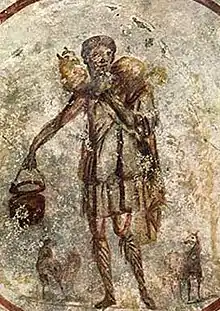
The Pontifical Commission for Sacred Archaeology[65] was created by Pius IX on 6 January 1852 "to take care of the ancient sacred cemeteries, look after their preventive preservation, further explorations, research and study, and also safeguard the oldest mementos of the early Christian centuries, the outstanding monuments and venerable Basilicas in Rome, in the Roman suburbs and soil, and in the other Dioceses in agreement with the respective Ordinaries". Pius XI made the Commission pontifical and expanded its powers.[66]
Pontifical Biblical Commission
The Pontifical Biblical Commission,[67] established 30 October 1902 by Pope Leo XIII, is a consultative body of scholars placed under the authority of the Congregation for the Doctrine of the Faith.[29] The commission's duties include:
- to protect and defend the integrity of the Catholic Faith in Biblical matters
- to further the progress of exposition of the Sacred Books, taking account of all recent discoveries
- to decide controversies on grave questions which may arise among Catholic scholars
- to give answers to Catholics throughout the world who may consult the Commission
- to see that the Vatican Library is properly furnished with codices and necessary books
- to publish studies on Scripture as occasion may demand.[68]
International Theological Commission
The International Theological Commission[69] (ITC) consists of 30 Catholic theologians from around the world. Its function is to advise the Congregation for the Doctrine of the Faith (CDF) of the Roman Catholic Church. The Prefect of the CDF is ex officio the president of the ITC, which is based in Rome.
Interdicasterial Commissions
A temporary commission is sometimes established to deal with a matter involving the work of several departments of the Roman Curia.
The Interdicasterial Commission for the Catechism of the Catholic Church was created in 1993 to prepare the definitive text in Latin of the Catechism of the Catholic Church.[70] It produced the authoritative Latin text (editio typica) of the Catechism in 1997.
Others exist for longer periods. The Standing Interdicasterial Commission for the Church in Eastern Europe, set up by Pope John Paul II on 15 January 1993, as of 2012 is presided over by the Cardinal Secretary of State. Its membership includes the Secretary and the Undersecretary for Relations with States, and the Secretaries of the Congregations for the Eastern Churches, for the Clergy, and for Institutes of Consecrated Life and Societies of Apostolic Life, and of the Pontifical Council for Promoting Christian Unity.[71]
Swiss Guard
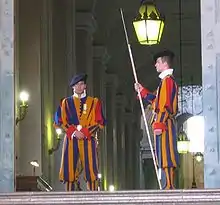
Since 1506, the "Corps of the Pontifical Swiss Guard" or "Swiss Guard", a small armed force, has been responsible for the safety of the Pope, including the security of the Apostolic Palace and access to Vatican City. It originated as a military combat unit and quickly evolved into a police force with responsibility for border control. Its official language is Swiss German. As of 2003, it consisted of 134 professional soldiers.[72]
Labour Office of the Apostolic See
The Labour Office of the Apostolic See[73] is responsible for labor relations of the Holy See with its employees. The office also settles labor issues which arise. It was instituted by Pope John Paul II on 1 January 1989 by an apostolic letter in the form of a motu proprio.[74]
See also
Notes
- The Holy See is often referred to as "the Vatican", a word of many meanings, since it can refer to the geographical area, known by that name even before Christianity, to the residence of the pope, to the Holy See, and to the State of Vatican City, which was created in 1929.
- "In exercising supreme, full, and immediate power in the universal Church, the Roman pontiff makes use of the departments of the Roman Curia which, therefore, perform their duties in his name and with his authority for the good of the churches and in the service of the sacred pastors."[4]
References
- Paul VI, Apostolic Constitution Regimini Ecclesiae universae, 15 August 1967, publ. in Acta Apostolicae Sedis 59 (1967), pp. 885–928.
- "Code of Canon Law - IntraText". www.vatican.va. Retrieved 10 April 2020.
- Herghelegiu, Monica-Elena, Reservatio Papalis, Lit Verlag, (Berlin, 2008), p.21, and chap. 2 passim.
- "Decree concerning the Pastoral Office of Bishops – Christus Dominus". Vatican.va. Retrieved 26 July 2013.
- The approved English translation of the text is available as a pdf download
- "BRIEFING SULLA RIUNIONE DEL CONSIGLIO DI CARDINALI (GIOVEDÌ 5 DICEMBRE 2013)". press.vatican.va. Archived from the original on 20 December 2013. Retrieved 15 October 2020.
- "Archived copy". Archived from the original on 17 December 2013. Retrieved 21 July 2017.CS1 maint: archived copy as title (link)
- "Council of cardinals begins second meeting on curial reform".
- "Pope to C6: Apostolic Constitution reform already underway". Vatican News. 14 October 2020. Retrieved 15 October 2020.
- Gagliarducci, Andrea (9 February 2015). "What are the theological criteria to reform the Church and the Roman Curia?". Catholic News Agency. Retrieved 29 August 2016.
- "The Submission of the Clergy and Restraint of Appeals, 1534". Archived from the original on 12 June 2008. Retrieved 26 July 2013.
- "Roman Curia (Roman Catholicism) – Encyclopædia Britannica". Britannica.com. Retrieved 26 July 2013.
- Ap. Const. Pastor Bonus, "Dicasteries"
- Pfnausch, Code, Community, Ministry, pg. 40; from James H. Provost, "Section I: Supreme Church Authority (cc. 330–367)" in "The Code of Canon Law: A Text and Commentary", ed. James A Coriden, et. al. (New York/Mahwah: Paulist Press, 1985) pp. 260–310.
- Wooden, Cindy (17 August 2016). "Pope names Dallas bishop head of new office for laity, family, life". National Catholic Reporter. Catholic News Service. Retrieved 28 August 2016.
- Winters, Michael Sean (17 August 2016). "Bishop Farrell heads to Rome: What it means". National Catholic Reporter. Retrieved 28 August 2016.
- McElwee, Joshua J. (31 August 2016). "Francis creates new Vatican office for charity, justice, peace, migration". National Catholic Reporter. Retrieved 31 August 2016.
- Bordoni, Linda (31 August 2016). "Migrants and refugees at the heart of Pope's new 'Motu Proprio'". Vatican Radio. Retrieved 31 August 2016.
- Reuters Staff (31 August 2016). "Pope to oversee migration issues in shakeup of Vatican offices". Reuters. Retrieved 15 October 2020.
- McElwee, Joshua J. (31 August 2016). "Francis creates new Vatican office for charity, justice, peace, migration". Retrieved 31 August 2016.
- "Pope Francis promulgates Motu Proprio instituting the 'Secretariat for Communications'". Vatican Radio. 27 June 2015. Retrieved 29 August 2016.
- Glatz, Carol (30 June 2015). "Pope creates new communications department to streamline Vatican media". Catholic Herald. Retrieved 29 August 2016.
- "Pope renames Vatican communications office". Vatican News. 23 June 2018. Retrieved 23 June 2018.
- "Congregations – Index". Vatican.va. Retrieved 26 July 2013.
- Wooden, Cindy. "Changing needs, changing names: Reform of Curia is Vatican tradition". The Catholic Sun. The Catholic Sun. Retrieved 13 April 2017.
- "Profile". Vatican.va. Retrieved 26 July 2013.
- "Congregation for the Oriental Churches". Vatican.va. Retrieved 26 July 2013.
- "Pastor Bonus, – John Paul II – Apostolic Constitution (June 28, 1988)". Vatican.va. 28 June 1988. Retrieved 26 July 2013.
- "Congregation for Divine Worship and the Discipline of the Sacraments – Index". Vatican.va. Retrieved 26 July 2013.
- "Congregation for the Causes of Saints". Vatican.va. Retrieved 26 July 2013.
- romeartlover. "Collegio di Propaganda Fide". Romeartlover.it. Retrieved 26 July 2013.
- Gagliarducci, Andrea (30 September 2014). "First woman appointed to a Vatican congregation joyful". Catholic News Agency. Retrieved 29 August 2016.
- Share; Twitter; Twitter; Twitter. "Manila archdiocese 'sede vacante' as Tagle leaves for the Vatican". www.pna.gov.ph. Retrieved 26 March 2020.
- "Congregation for the Clergy". Vatican.va. Retrieved 26 July 2013.
- "The Congregation For Institutes of Consecrated Life". Vatican.va. Retrieved 26 July 2013.
- "Profile". Vatican.va. Retrieved 26 July 2013.
- "Congregation for Bishops – Index". Vatican.va. Retrieved 26 July 2013.
- "Apostolic Penitentiary – Index". Vatican.va. Retrieved 26 July 2013.
- "Pastor Bonus, Table of Contents – John Paul II – Apostolic Constitution (28 June 1988)". Vatican.va. 28 June 1988. Retrieved 26 July 2013.
- Codex Canonum Ecclesiarum Orientalium [CCEO] canon 1065
- Codex Iuris Canonici [CIC] canons 1443, 1444.
- "The See of Peter – TRIBUNALS". Ewtn.com. Retrieved 26 July 2013.
- Edward Peters, Canon Law—Canonistics—Rota Background, http://www.canonlaw.info/personal_rotademo.htm (updated 21 October 2006).
- "Apostolic Signatura". Vatican.va. 4 February 2011. Retrieved 26 July 2013.
- "Code of Canon Law – IntraText". Vatican.va. Retrieved 26 July 2013.
- "Code of Canon Law – IntraText". Vatican.va. Retrieved 26 July 2013.
- "The Holy See – The Roman Curia – Pontifical Councils – Pontifical Council for Promoting Christian Unity". Vatican.va. Retrieved 26 July 2013.
- "Pontifical Council for the Interpretation of Legislative Texts – Index". Vatican.va. Retrieved 26 July 2013.
- Pastor Bonus, 154
- "The Holy See – The Roman Curia – Pontifical Councils – Pontifical Council for Inter-religious Dialogue". Vatican.va. Retrieved 26 July 2013.
- 'Pontifical Council for Culture' Retrieved 26 November 2012.
- "Pontifical Council for Promoting the New Evangelization". Vatican.va. Retrieved 26 July 2013.
- "Apostolic Camera". Vatican.va. Retrieved 26 July 2013.
- "Administration of the Patrimony of the Apostolic See (A.P.S.A.) – Index". Vatican.va. Retrieved 26 July 2013.
- Pastor bonus, 172)
- Annuario Pontificio 2012 (ISBN 978-88-209-8722-0), p. 1846
- "Prefecture for the Economic Affairs of the Holy See – Index". Vatican.va. Retrieved 26 July 2013.
- "Pontifical Commission for the Cultural Heritage of the Church – Index". Vatican.va. Retrieved 26 July 2013.
- "The Holy See – The Roman Curia – Pontifical Commissions – Pontifical Commission "Ecclesia Dei"". Vatican.va. 30 April 2011. Retrieved 26 July 2013.
- "Motu Proprio 'Ecclesiae Unitatem' concerning the Pontifical Commission 'Ecclesia Dei'". Vatican.va. Retrieved 26 July 2013.
- "Doctrinal congregation to handle relations with traditionalist Catholics". National Catholic Reporter. 22 January 2019. Retrieved 15 October 2020.
- "Pontifical Commission for Latin America". Vatican.va. Retrieved 26 July 2013.
- "Comunicato della Sala Stampa: Istituzione della Pontificia Commissione per la Tutela dei Minori". Holy See Press Office. 22 March 2014. Retrieved 30 March 2014.
- "Pontifical Commission for Sacred Archeology – Index". Vatican.va. Retrieved 26 July 2013.
- "I Primitivi Cemeteri, Motu Proprio che istituisce il Pontificio Istituto di Archeologia Cristiana, 11 dicembre 1925, Pio XI". Vatican.va. Retrieved 26 July 2013.
- "Pontifical Biblical Commission – Index". Vatican.va. Retrieved 26 July 2013.
- The Biblical Commission, John Corbett, The Catholic Encyclopedia, Volume II. Published 1907. New York: Robert Appleton Company. Nihil Obstat, 1907. Remy Lafort, S.T.D., Censor. Imprimatur. +John M. Farley, Archbishop of New York
- "International Theological Commission – Index". Vatican.va. Retrieved 26 July 2013.
- "Interdicasterial Commission for the Catechism of the Catholic Church". Vatican.va. 15 June 1992. Retrieved 26 July 2013.
- Annuario Pontificio 2012, pp. 1202–1203
- Royal, Robert (2006). The Pope's Army: 500 Years of the Papal Swiss Guard. Crossroads Publishing Co.
- "The Holy See – The Roman Curia – Labour Office of the Apostolic See". Vatican.va. Retrieved 26 July 2013.
- "MOTU PROPRIO Statuto Ufficio Lavoro Sede Apostolica". Vatican.va. Retrieved 26 July 2013.
Further reading
- Bouix, Dominique (1859). Tractatus de curia romana: seu de cardinalibus, romanis congregationibus, legatis, nuntiis, vicariis et protonotariis apostolicis (in Latin). Paris: apud Jacobum Lecoffre et Socios.
- De Luca, Giovanni Battista (1683). Relatio Curiae Romanae (in Latin). Cologne: Arnoldus Metternich.
- Rusch, Borwin (1936). Die Behörden und Hofbeamten der päpstlichen Kurie des 13. Jahrhunderts (in German). Konigsberg: Ost-Europa-Verlag.
- Grimaldi, Félix (1890). Les congrégations romaines guide: historique et pratique (in French). Siena: Imprimerie San Bernardino.
- Martin, Michael (1913). The Roman Curia as it Now Exists: An Account of Its Departments: Sacred Congregations, Tribunals, Offices; Competence of Each; Mode of Procedure; how to Hold Communication With: the Latest Legislation. New York: Benziger. p. 427.
- Pratica della curia romana che comprende la giurisdizione de' tribunali di Roma, e dello stato; e l'ordine giudiziario, che in essi si osserva. Con una raccolta di costituzioni, editti, riforme, regiudicate, decreti &c (in Italian). Roma: nella stamperia di Giovanni Zempel. 1781. p. 256.
External links
- Official website
- The Roman Curia by GCatholic.org
- The Roman Curia
- Ojetti, Benedetto (1913). . Catholic Encyclopedia.
- Boudinhon, Auguste (1911). . Encyclopædia Britannica (11th ed.).
